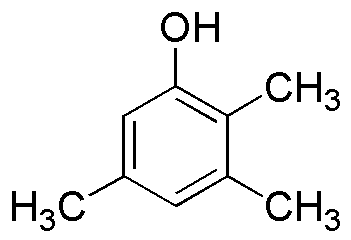2,3,5-Trimethylphenol is widely utilized in research focused on:
- Antioxidant Additives: This compound is often used in the formulation of antioxidant additives for plastics and rubber, enhancing their durability and resistance to degradation over time.
- Pharmaceuticals: It serves as an intermediate in the synthesis of various pharmaceuticals, contributing to the development of effective medications.
- Personal Care Products: Commonly found in cosmetics and personal care items, it helps improve product stability and shelf life while providing antimicrobial properties.
- Industrial Applications: Used in the production of coatings and adhesives, it enhances the performance and longevity of these materials in various industrial settings.
- Research and Development: In laboratories, it is utilized as a reagent in organic synthesis, aiding researchers in developing new compounds and materials.
Informations générales
Propriétés
Sécurité et réglementation
Applications
2,3,5-Trimethylphenol is widely utilized in research focused on:
- Antioxidant Additives: This compound is often used in the formulation of antioxidant additives for plastics and rubber, enhancing their durability and resistance to degradation over time.
- Pharmaceuticals: It serves as an intermediate in the synthesis of various pharmaceuticals, contributing to the development of effective medications.
- Personal Care Products: Commonly found in cosmetics and personal care items, it helps improve product stability and shelf life while providing antimicrobial properties.
- Industrial Applications: Used in the production of coatings and adhesives, it enhances the performance and longevity of these materials in various industrial settings.
- Research and Development: In laboratories, it is utilized as a reagent in organic synthesis, aiding researchers in developing new compounds and materials.
Documents
Fiches de données de sécurité (FDS)
La FDS fournit des informations de sécurité complètes sur la manipulation, le stockage et l’élimination du produit.
Spécifications du produit (PS)
Le PS fournit une description complète des propriétés du produit, notamment sa composition chimique, son état physique, sa pureté et les exigences de stockage. Il détaille également les plages de qualité acceptables et les applications prévues du produit.
Certificats d'analyse (COA)
Recherchez des certificats d'analyse (COA) en saisissant le numéro de lot du produit. Les numéros de lot et de lot se trouvent sur l'étiquette d'un produit, après les mots « Lot » ou « Lot de fabrication ».
Numéro de catalogue
Numéro de lot/série
Certificats d'origine (COO)
Ce certificat d'exploitation confirme le pays dans lequel le produit a été fabriqué, et détaille également les matériaux et composants utilisés et s'il est issu de sources naturelles, synthétiques ou autres sources spécifiques. Ce certificat peut être requis pour les douanes, le commerce et la conformité réglementaire.
Numéro de catalogue
Numéro de lot/série
Fiches de données de sécurité (FDS)
La FDS fournit des informations de sécurité complètes sur la manipulation, le stockage et l’élimination du produit.
DownloadSpécifications du produit (PS)
Le PS fournit une description complète des propriétés du produit, notamment sa composition chimique, son état physique, sa pureté et les exigences de stockage. Il détaille également les plages de qualité acceptables et les applications prévues du produit.
DownloadCertificats d'analyse (COA)
Recherchez des certificats d'analyse (COA) en saisissant le numéro de lot du produit. Les numéros de lot et de lot se trouvent sur l'étiquette d'un produit, après les mots « Lot » ou « Lot de fabrication ».
Numéro de catalogue
Numéro de lot/série
Certificats d'origine (COO)
Ce certificat d'exploitation confirme le pays dans lequel le produit a été fabriqué, et détaille également les matériaux et composants utilisés et s'il est issu de sources naturelles, synthétiques ou autres sources spécifiques. Ce certificat peut être requis pour les douanes, le commerce et la conformité réglementaire.


